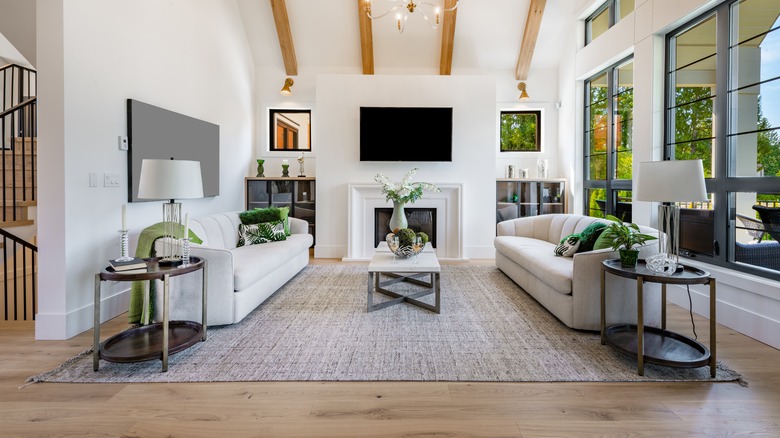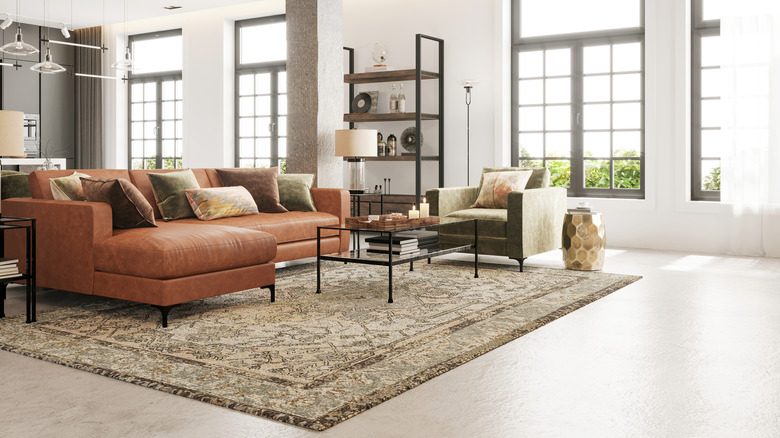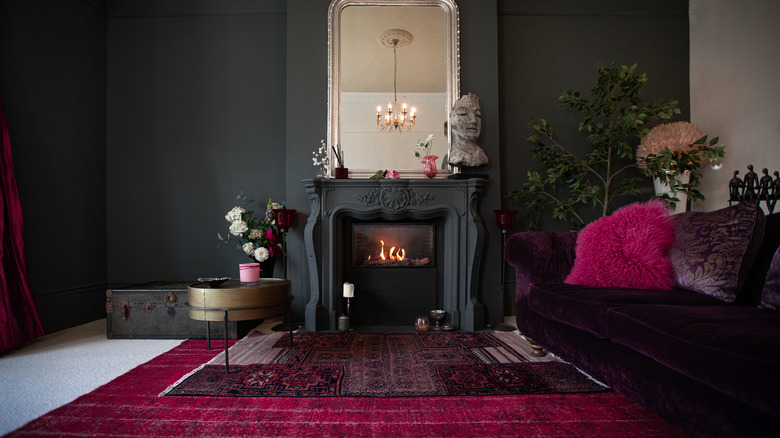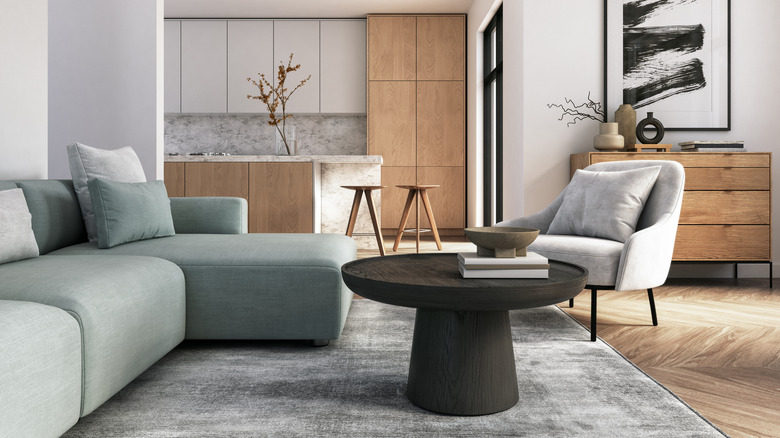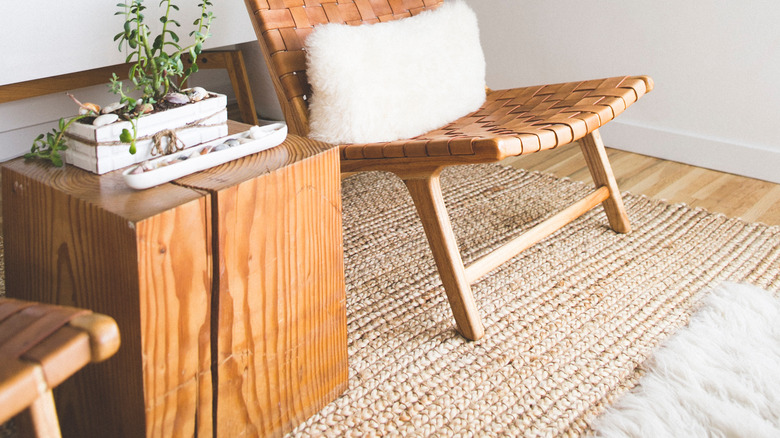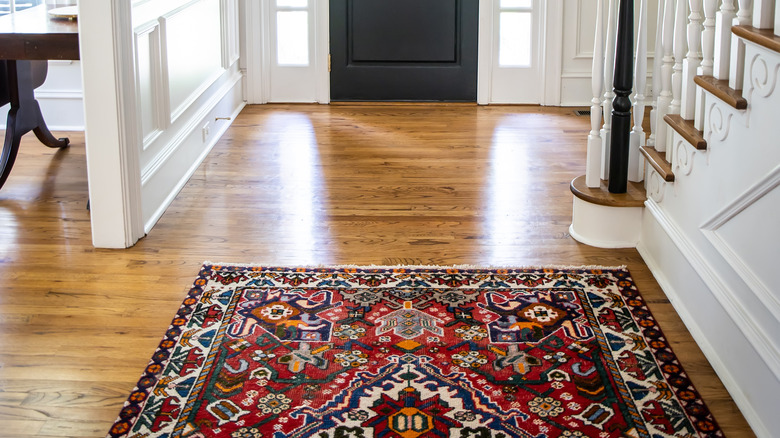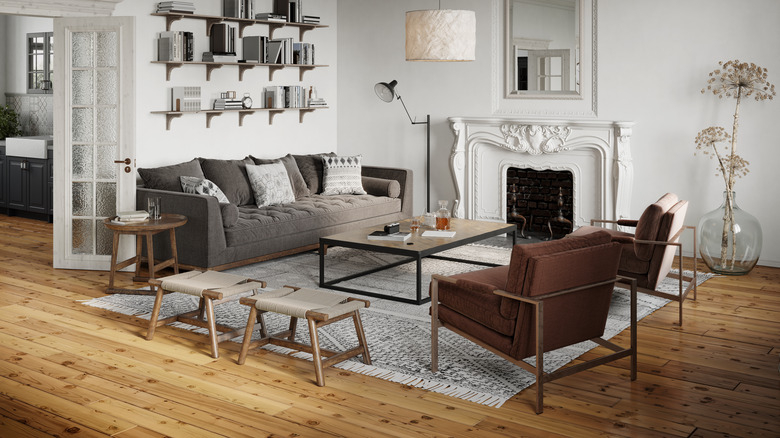Steps You Shouldn't Skip When Choosing An Area Rug, According To Our Home Design Experts
Area rugs are a popular decor choice for people looking for a relatively inexpensive way to transform their room's appearance. The best thing about them is that they are versatile. They can add a splash of color to the gloomiest room, feel luxurious underfoot, and are appealingly inviting. Best of all, they can be easily swapped with other rugs when you feel like creating a new theme or focal point for your space.
Area rugs are also practical. They can help protect your flooring, are easier to clean than carpets, anchor furniture, reduce noise, and can help add a little warmth and comfort to any room. They come in all shapes and sizes, colors and designs, and can do for your floors what works of art do for your walls. However, to maximize their true potential, there are a few things you need to consider before buying one. For example, does it match the scale of your room, and does it help achieve the mood you're trying to create? Here are the steps you shouldn't skip when choosing an area rug, according to our professional decor designers.
Figuring out the size needed for your specific room
The size of the area rug is all-important. A rug's job is to complement and enhance the room, not detract from or diminish it. So when it is the right size, it ties things together and brings balance. "It's important to pick a rug that is equal to the room's size and furniture placement. A rug that is too small could feel detached and visually out of place, while a rug that is too big could overwhelm the space and make it look stuffy," interior designer Sylvia Li tells House Digest exclusively. "Choose a rug that will fit the seating area well and allow the furniture to rest partially or totally on it. This will produce a unified and harmonious appearance that will improve the room's overall beauty."
It's a good idea to record the measurements of your seating area before determining the size of your rug. To maintain the scale and balance of the room, it's recommended to leave a gap of 15 inches where the rug ends and the wall begins. While it's visually pleasing to have the furniture fully anchored on the carpeting, it's not completely necessary. This is good news since extra large area rugs can be pricey. As long as the floor covering is eight inches wider than your sofa on either side, and the front legs of your furniture rest on the rug and the back legs lie on the floor, the room will look cohesive. This is especially recommended if you're decorating a smaller room, since the rug won't visually take up the entire space.
Assessing whether a dark or light rug would be best
When it's time to start considering color, the size of your room can help you narrow down the selections. Depending on your room's size, you should choose either a light or dark-colored hue. "A darker rug could make a small room feel snug," Ryan Fitzgerald, realtor and the owner of Up Homes, tells House Digest. This is particularly true if your room has dark walls, flooring, and a lot of dark furniture. "If the goal is to create an illusion of more visual space, opting for a lighter-colored rug can be beneficial," Jenna Shaughnessy, home decorating expert at Jenna Kate at Home, said. "Lighter rugs tend to make a room feel more open and spacious. They reflect light and make the floor appear larger, which can be particularly advantageous in smaller rooms or areas with limited natural light."
For large rooms, a darker rug can help create a more atmospheric and intimate look. You have the space and freedom to be a bit more adventurous in open-planned areas. A rug can serve as a focal point in such places, and a dark and rich color can help add definition and atmosphere.
Matching the rug to your decor scheme
So you've selected the size and color of an area rug that'll best fit your room, but have you considered if it matches your decor scheme? Get it right, and the rug will enhance your space in myriad ways. Get it wrong, and the rug can undo all the hard work you've done elsewhere. "Consider the overall color palette of the room," advised Debbie DeMarais, the owner of DeMarais Home Staging + Design. "This is usually determined by the major pieces of furniture, artwork, and decor that are already present — so look around the space to get a sense of the predominant colors being used. If you're seeing a lot of deep dark colors, then you're going to want a darker-colored rug to help ground the furniture." Also, pay special attention to the temperature of your decor. Is it more cool leaning, utilizing lots of blues, greens, and grays? Or is it warm, playing with deep reds, purples, and browns? Your rug should mirror the same temperature.
For rooms that are more neutral, DeMarais explains there are a lot more options for choosing an area rug. "For a neutral-colored room, there's more freedom in the choice of rug color because the rug can either become a bold accent in the space, adding color and drama to help set a mood, or a neutral-colored rug can be selected to keep a minimal vibe," she explained. You can choose to either keep the space airy and calm with a natural fiber rug — such as jute, tufted wool, or a furry shag — or add a pop of color, such as with a Morrocan rug. Just make sure to keep an eye on temperature still.
Looking for variation in tone and texture
Be careful that you pay attention to tone and texture when choosing the color of your area rug, especially if you prefer neutral or minimalist spaces. While it might seem easy to put together a neutral room due to the fact it has a limited color palette — you typically only reach for whites, grays, beiges, and earth tones — it can be quite tricky. That's because those rooms have a tendency to look one-dimensional or washed out when they're not carefully layered. And a great way to add some dimension is through texture. "Choosing a rug with subtle variations in tone or texture can help break up large expanses of solid-colored flooring and add visual interest without overwhelming the space," Ilia Mundut, founder of HeftyBerry, a home decor retailer, tells us.
For example, if you have cream-colored walls, a white sofa, and light birchwood side tables, try introducing a textured rug to add some life to the space. This can include a woven sisal area rug, a gritty jute one, a tufted wool option, or perhaps even a shag cream-colored one. Choose something with lots of texture, and have the color play off the shades already in the room. Adding this extra element makes the space more dynamic and inviting rather than flat.
Considering if the rug is in low- or high-traffic spaces
It's a common mistake to choose a rug solely from an aesthetic viewpoint. You also need to give serious thought to the practicality of the material it is made from and if it'll be located in a high or low-traffic space. For example, you want to avoid high-pile or shag rugs in busy areas, since they're difficult to clean, trap dirt and allergens, and are high maintenance by easily losing shape. For high-traffic areas such as hallways and entryways, natural fibers look great, and wool, cotton, and jute are very durable and easy to maintain. Rugs made from synthetic materials such as nylon and polyester are also effective, with the added bonus they're less expensive. They're also treated to make them more resistant to the stains and spills of chaotic family life.
As interior designer Alexandra Cooper points out to us, choosing a darker shade rug for areas with a high footfall is usually wise. "Light-colored rugs can show dirt, stains, and wear more easily compared to darker carpets. Choosing a rug with a darker tone can help hide these imperfections and make maintenance easier." In low-traffic areas such as a bedroom or a study, you can go for gold with a rug made to feel and look like a cloud — such as a nice white shag.
Planning out the overall mood you want to create
Like any furnishing or textile, an area rug's role is to contribute to the overall mood of your room. Color is the single most important element when creating a mood, and this should be reflected in your rug. Alexandra Cooper advises, "Light-colored rugs tend to create a more airy, serene, and modern ambiance, while darker rugs can add warmth, richness, and a traditional touch."
Rugs containing darker and warmer tones, such as reds, rich browns, soft yellows, and oranges, all evoke excitement and passion. They can help create a comfortable, dynamic room that can recharge your batteries after a long, monotonous day. Rugs made from lighter and cooler tones such as blues, whites, and grays aid relaxation and are conducive to feelings of calmness. They can open up a space and help the room breathe. Rugs consisting of earth tones such as beige, tan, and soft greens have an understated elegance and make you feel more connected with nature. Depending on which color you choose, a different theme will be created. Remember, the carpet alone does not make a room, but it can certainly make a huge impact if chosen with diligence and care.
